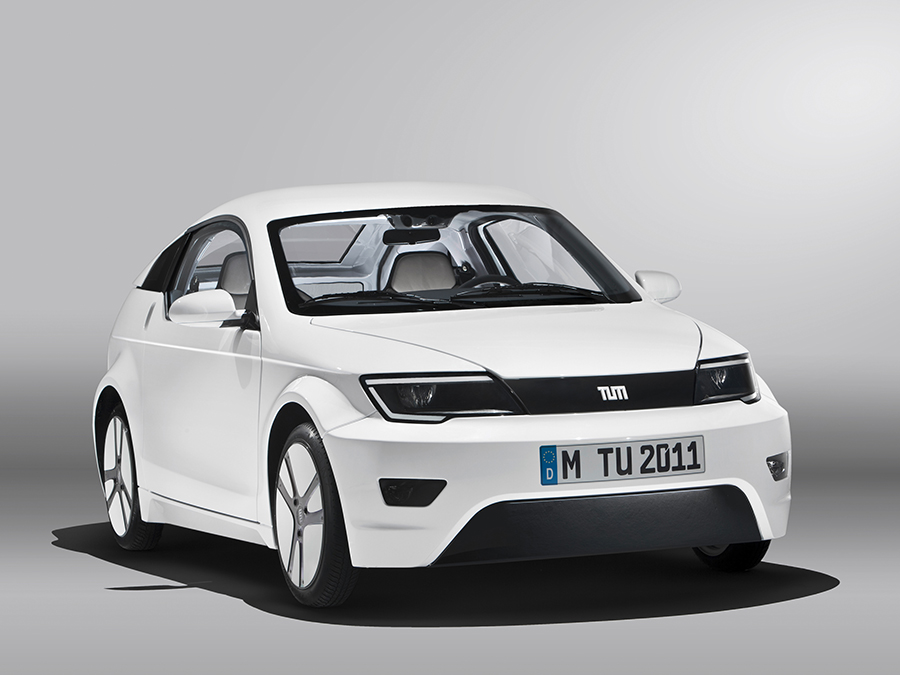TU München presents its electromobility vehicle concept MUTE
MUTE: the efficient city car

With MUTE, researchers from the TU München have created an agile, sporty two-seater for regional road traffic. It has space sufficient for two persons plus luggage. The L7E certified electric motor, which is electronically limited to 15 kW, accelerates the light vehicle to 120 km/h. The lithium-ion battery is designed to guarantee a range of at least 100 kilometers. When needed, a zinc-air battery serves as a range extender – a “reserve” battery, as it were. Its sporty suspension and the active torque vectoring differential drive ensure good cornering stability and excellent driving performance.
The MUTE design conveys a snazzy, self-confident appearance. The built-in features fulfill all essential requirements of a modern road vehicle. A safety package, including an electronic stability program (ESP) system, a robust passenger compartment and crash elements made of carbon fiber reinforced plastic, imparts a high level of safety to the vehicle. Regarding ergonomics and comfort, here too, the MUTE concept leapfrogs other developments to date in the L7E class.
Decisive for the great efficiency of the MUTE is its low weight. A stable vehicle frame made of aluminum and a chassis made of carbon fiber reinforced plastic reduces the curb weight, including batteries, to a mere 500 kilograms. “Low weight is essential for an electric vehicle,” says the TUM vehicle engineer Prof. Markus Lienkamp. “Greater weight requires more battery performance for the same range, which results in higher costs. Greater weight also results in reduced dynamics for a given power output. But we want a car that is affordable and fun to drive.”
A further contribution to efficiency comes from the torque vectoring differential: A small electrical motor in the differential that functions both as a motor and as a generator serves to ideally distribute the forces between the two back tires. Especially when braking in curves, twice as much energy can be recovered as without the torque vectoring technology. At the same time, the advantageous distribution of drive and braking forces makes the car much more agile and also safer.
MUTE has been newly developed from scratch. Every part has been optimized for three main factors: efficiency, low overall cost and safety. Extensive preliminary studies were carried out to ascertain what mobility of the future will look like, what customer requirements will be decisive in purchasing decisions and how these might be fulfilled in a cost-effective and weight-saving manner. This led, among other things, to all tertiary user interface elements (e.g., for navigation and infotainment) being collected into a central touchpad. In addition, the touchpad computer can be used as a mobile interface for server-based, value-added services. This will allow the owner to check the current charging status using a smartphone. While under way, the most energy-efficient route (not only the shortest or fastest) can be determined based on the current traffic situation.
Over 200 staff members of 20 departments of TU München’s Science Center for Electromobility joined forces to develop the MUTE concept. The research network belongs to the cross-faculty research initiative TUM.Energy, which bundles the extensive, long-term research activities of more than 100 departments in eight faculties on the topic of energy to a competence center with international prominence. The Science Center for Electromobility provides testing infrastructure, central test beds and the possibility for building shared prototypes. At the same time it is a docking station for national and international cooperation with research departments in industry and academia. The MUTE prototype was built with funding from the university budget and the Bavarian Research Foundation (BFS); project partners were C-CON, Gerg RPT and IAV. R&R; KFZ did the vehicle construction. The TUM holds the intellectual property rights for overall concept. Over 30 partners from industry support the project as a whole.
MUTE represents the official start of the MUNICH SCHOOL OF ENGINEERING, which places its research focus on the key future topic of “Energy – Green Technologies,” and educates particularly well-qualified engineering students with an emphasis on research and interdisciplinary.
Photos:
http://mediatum.ub.tum.de/?id=1083732
MUTE project website:
http://www.mute-automobile.de/en/home.html
Technical University of Munich
Corporate Communications Center
- Dr. Andreas Battenberg
- battenberg@zv.tum.de
- presse@tum.de
- Teamwebsite